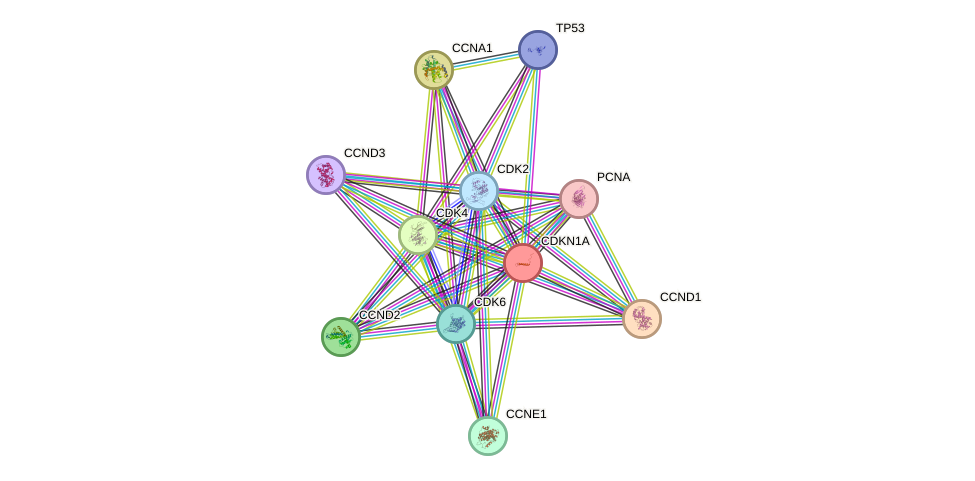GenAge entry for CDKN1A (Homo sapiens)
Gene name (HAGRID: 284)
- HGNC symbol
- CDKN1A
- Aliases
- P21; CIP1; WAF1; SDI1; CAP20; p21CIP1; p21Cip1/Waf1; CDKN1
- Common name
- cyclin-dependent kinase inhibitor 1A (p21, Cip1)
Potential relevance to the human ageing process
- Main reason for selection
- Entry selected based on evidence directly linking the gene product to ageing in a cellular model system
- Description
The tumor suppressor CDKN1A, also known as p21, is a cyclin-dependent kinase inhibitor of CDK2 and CDK4 complexes, and regulates cell cycle progression at G1 via RB1 [2217]. CDKN1A is tightly controlled by p53 (TP53) and its induction predominantly leads to cell cycle arrest, while its repression may have different outcomes depending on context [2218]. Up to now, CDKN1A has been linked to cancer in multiple ways.
Mice lacking p21 undergo normal development, but are defective in G1 checkpoint control [2219]. The deletion of p21 in mice with dysfunctional telomeres prolonged lifespan. The mice exhibited improved hematolymphopoiesis and maintenance of intestinal epithelia without rescuing telomere function. Moreover, they showed rescued proliferation of intestinal progenitor cells and improved repopulation capacity and self-renewal of hematopoietic stem cells [2220]. In mice, using the ear hole closure phenotype, it was shown that regeneration occurs much faster in p21-deficient animals than in controls [2221].
In human cells, an increase in the mRNA level of CDKN1A was observed upon stress-induced premature senescence [2222]. In a study of human longevity polymorphisms two CDKN1A alleles, which are very rare in Italian centenarians, have been identified, leading to the suggestion that they might have potentially detrimental effect to longevity [2223]. Clearly, CDKN1A plays a role in cancer and cell senescence, but its role in human ageing remains unknown.
Cytogenetic information
- Cytogenetic band
- 6p21.2
- Location
- 36,678,679 bp to 36,687,339 bp
- Orientation
- Plus strand
Protein information
- Gene Ontology
-
Process: GO:0000079; regulation of cyclin-dependent protein serine/threonine kinase activity
GO:0000082; G1/S transition of mitotic cell cycle
GO:0000086; G2/M transition of mitotic cell cycle
GO:0006974; cellular response to DNA damage stimulus
GO:0006977; DNA damage response, signal transduction by p53 class mediator resulting in cell cycle arrest
GO:0006978; DNA damage response, signal transduction by p53 class mediator resulting in transcription of p21 class mediator
GO:0007050; cell cycle arrest
GO:0007265; Ras protein signal transduction
GO:0008285; negative regulation of cell proliferation
GO:0009636; response to toxic substance
GO:0010165; response to X-ray
GO:0010243; response to organonitrogen compound
GO:0010629; negative regulation of gene expression
GO:0030308; negative regulation of cell growth
GO:0030890; positive regulation of B cell proliferation
GO:0031100; animal organ regeneration
GO:0031668; cellular response to extracellular stimulus
GO:0033158; regulation of protein import into nucleus, translocation
GO:0034198; cellular response to amino acid starvation
GO:0034605; cellular response to heat
GO:0042326; negative regulation of phosphorylation
GO:0042493; response to drug
GO:0042771; intrinsic apoptotic signaling pathway in response to DNA damage by p53 class mediator
GO:0043066; negative regulation of apoptotic process
GO:0043068; positive regulation of programmed cell death
GO:0045736; negative regulation of cyclin-dependent protein serine/threonine kinase activity
GO:0045860; positive regulation of protein kinase activity
GO:0046685; response to arsenic-containing substance
GO:0048146; positive regulation of fibroblast proliferation
GO:0050821; protein stabilization
GO:0051412; response to corticosterone
GO:0055093; response to hyperoxia
GO:0060574; intestinal epithelial cell maturation
GO:0071479; cellular response to ionizing radiation
GO:0071480; cellular response to gamma radiation
GO:0071493; cellular response to UV-B
GO:0071850; mitotic cell cycle arrest
GO:0090398; cellular senescence
GO:0090399; replicative senescence
GO:0090400; stress-induced premature senescence
GO:0097193; intrinsic apoptotic signaling pathway
GO:1904031; positive regulation of cyclin-dependent protein kinase activity
GO:2000134; negative regulation of G1/S transition of mitotic cell cycle
GO:2000278; regulation of DNA biosynthetic process
GO:2000379; positive regulation of reactive oxygen species metabolic process
Cellular component: GO:0000307; cyclin-dependent protein kinase holoenzyme complex
GO:0005634; nucleus
GO:0005654; nucleoplasm
GO:0005730; nucleolus
GO:0005829; cytosol
GO:0043234; protein complex
GO:0048471; perinuclear region of cytoplasm
GO:0070557; PCNA-p21 complex
Hide GO termsFunction: GO:0004861; cyclin-dependent protein serine/threonine kinase inhibitor activity
GO:0005515; protein binding
GO:0019912; cyclin-dependent protein kinase activating kinase activity
GO:0030332; cyclin binding
GO:0031625; ubiquitin protein ligase binding
GO:0032403; protein complex binding
GO:0046872; metal ion binding
Protein interactions and network
- Protein-protein interacting partners in GenAge
- TP53, TXN, E2F1, STAT3, AKT1, NGFR, NCOR1, PARP1, CREBBP, UBB, VCP, HSP90AA1, CEBPA, EP300, PCNA, RB1, FOXO1, APP, A2M, HDAC1, HSPA9, HSPA1A, MAPK8, JUN, CCNA2, MAP3K5, EEF1A1, HSPA8, CDK1, HDAC2, MDM2, ESR1, TP63, NCOR2, NFE2L2
- STRING interaction network
Retrieve sequences for CDKN1A
Homologs in model organisms
In other databases
- GenAge model organism genes
- A homolog of this gene for Mus musculus is present as Cdkn1a
- GenAge microarray genes
- This gene is present as CDKN1A
- LongevityMap
- This gene is present as CDKN1A
- CellAge
- This gene is present as CDKN1A
- CellAge gene expression
- This gene is present as CDKN1A

